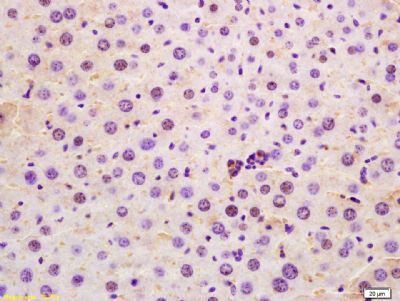产品货号 : mlR8067
英文名称 : SRRM2
中文名称 : 丝氨酸/精氨酸相关核基质蛋白2抗体
别 名 : 300 kDa nuclear matrix antigen; CWC21; KIAA0324; Ser/Arg-related nuclear matrix protein of 300 kDa; Serine/arginine repetitive matrix protein 2; Serine/arginine-rich splicing factor-related nuclear matrix protein of 300 kDa; Splicing coactivator subunit SRm300; SR-related nuclear matrix protein of 300 kDa; SRL300; SRM300; SRRM2; SRRM2_HUMAN; Tax-responsive enhancer element-binding protein 803; TaxREB803.
研究领域 : 肿瘤 细胞生物 表观遗传学
抗体来源 : Rabbit
克隆类型 : Polyclonal
交叉反应 : Human, Mouse, Rat, Dog, Pig, Cow, Rabbit,
产品应用 : ELISA=1:500-1000 IHC-P=1:400-800 IHC-F=1:400-800 IF=1:100-500 (石蜡切片需做抗原修复)
not yet tested in other applications.
optimal dilutions/concentrations should be determined by the end user.
分 子 量 : 299kDa
细胞定位 : 细胞核
性 状 : Lyophilized or Liquid
浓 度 : 1mg/ml
免 疫 原 : KLH conjugated synthetic peptide derived from human SRRM2:101-230/2752
亚 型 : IgG
纯化方法 : affinity purified by Protein A
储 存 液 : 0.01M TBS(pH7.4) with 1% BSA, 0.03% Proclin300 and 50% Glycerol.
保存条件 : Store at -20 °C for one year. Avoid repeated freeze/thaw cycles. The lyophilized antibody is stable at room temperature for at least one month and for greater than a year when kept at -20°C. When reconstituted in sterile pH 7.4 0.01M PBS or diluent of antibody the antibody is stable for at least two weeks at 2-4 °C.
PubMed : PubMed
产品介绍 : The SRm160/300 splicing coactivator, which consists of the serine/arginine (SR)-related nuclear matrix protein and a nuclear matrix antigen, functions in splicing by promoting critical interactions between splicing factors bound to pre-mRNA. This splicing pathway involves five core small nuclear ribonucleoprotein particles (snRNPs) and the SR family proteins, which coordinately bind to pre-mRNA slicing enhancer elements, are required for accurate splice site recognition, and regulate alterative splicing patterns. The recognized splicing enhancer elements, known also as exonic enhancer splicing sequences, are short RNA sequences that are capable of activating weak splice sites in adjacent introns and contain specific binding sites for the serine/arginine (SR)-rich splicing factors. SRm160 and 300 antigens contain domains rich in SR motifs, but are distinctly different from the SR factors as they lack an RNA recognition motif and cannot directly induce RNA splicing. These proteins rather function as coactivators that stabilize the splicing complex and mediate the U1 snRNP-splicing pathway.
Function:
Involved in pre-mRNA splicing. May function at or prior to the first catalytic step of splicing at the catalytic center of the spliceosome. May do so by stabilizing the catalytic center or the position of the RNA substrate By similarity. Binds to RNA.
Subunit:
Component of the active spliceosome. Found in a pre-mRNA splicing complex with SFRS4, SFRS5, SNRP70, SNRPA1, SRRM1 and SRRM2. Identified in the spliceosome C complex.
Subcellular Location:
Nucleus speckle.
Tissue Specificity:
Expressed in liver, placenta, and white blood cells.
Post-translational modifications:
Phosphorylated upon DNA damage, probably by ATM or ATR.
Similarity:
Belongs to the CWC21 family.
SWISS:
Q9UQ35
Gene ID:
23524
Important Note:
This product as supplied is intended for research use only, not for use in human, therapeutic or diagnostic applications.
产品图片












